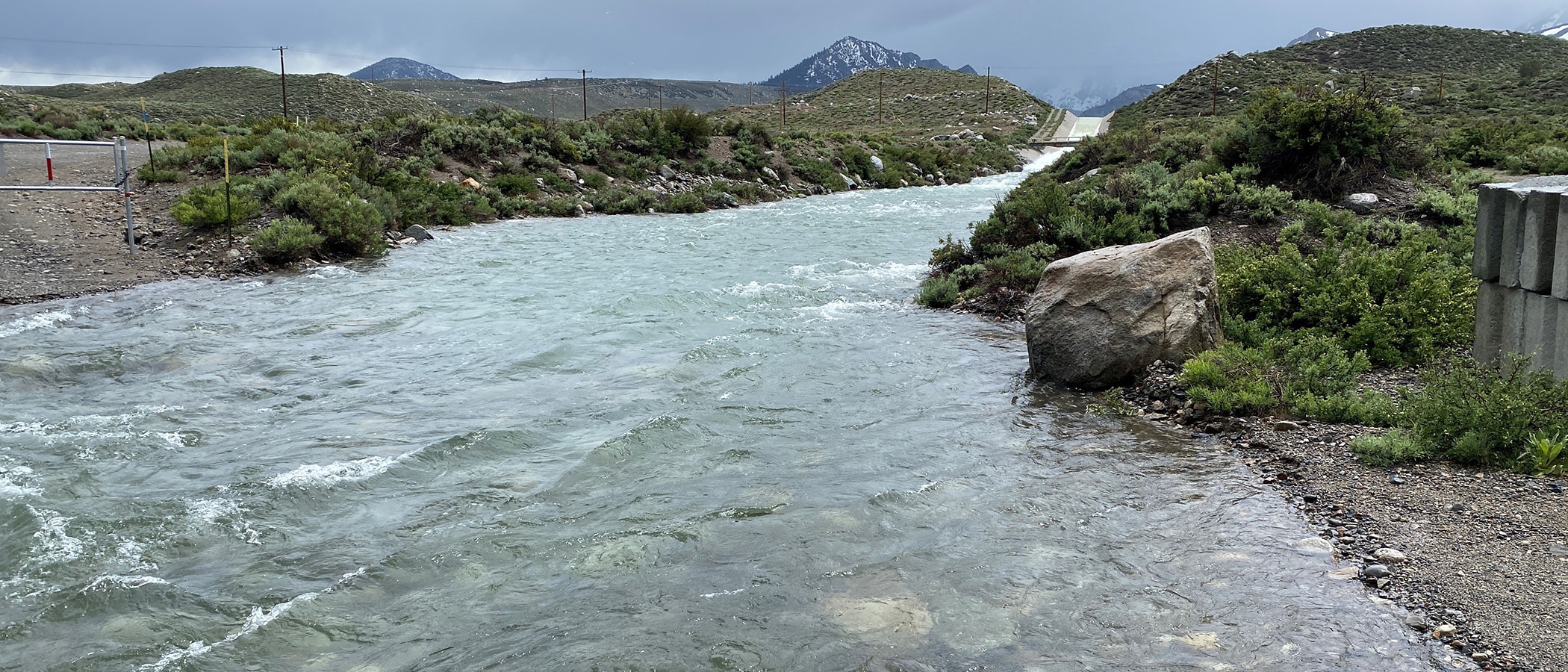
Spillway upgrade construction tentatively planned for next spring
One of the few dams without an outlet in the state of California is soon to get one—modification of the Grant Lake Reservoir dam may begin as early as next spring. The Los Angeles Department of Water & Power (DWP) has not confirmed a construction start date but is working toward an April 2024 timeframe as project bidding, permits, and reservoir levels allow.
The successful restoration of Rush Creek depends on the modification of Grant Dam. The dam was built without a direct way to pass water downstream into Rush Creek except for an emergency spillway. The aging 20th century structure was built on the premise of 19th century water rights values—that water flowing naturally in a stream was wasted water. DWP built the earthen dam and diversion infrastructure in the 1930s as part of the Mono Basin Extension of the Los Angeles Aqueduct. For decades the dam prevented lower Rush Creek from receiving any water. As litigation affirmed Fish & Game Codes and Public Trust values of both Mono Lake and fish in its tributary streams, small amounts of water were released into lower Rush Creek beginning in the 1980s. Subsequent California State Water Resource Control Board orders mandated increased restoration flows that the current system is unable to deliver in wet years.
Essential to restoration
In 2021 the State Water Board amended DWP’s water licenses and ordered that DWP construct an outlet that reliably delivers stream ecosystem flows (SEFs) to Rush Creek. The Board’s Order 21-86 was the culmination and implementation of a voluntary Stream Restoration Agreement which the Mono Lake Committee, along with California Trout and the California Department of Fish & Wildlife, signed with DWP to commit to the restoration of Mono Basin streams. Order 21-86 included multiple detailed steps to fulfill the next chapter of science-based stream restoration in the Mono Basin. The construction of an outlet that can deliver the SEFs is essential to achieve that restoration.
The new outlet will be constructed in the existing emergency spillway. DWP will widen and deepen the spillway and install two 14-foot-tall Langemann gates that will allow for controlled releases at lower reservoir levels than the spillway currently allows. DWP completed the project’s environmental review in 2020. Earlier this year DWP formally requested a deadline extension from the State Water Board to begin construction in the spring of 2025. The State Water Board granted the extension, but DWP is planning to begin construction next year.
Fixing an awkward work-around
Moving water around Grant Dam and into Rush Creek has long involved an indirect work-around via an aging valve, aqueduct intake tunnel, modified gate, and return ditch. This system cannot reliably deliver the sufficient volume of water necessary to accurately mimic the natural hydrograph and restore the creek in wetter-than-average runoff year-types. This summer for example, Rush Creek was supposed to receive a minimum of 750 cubic feet per second during the peak runoff for at least five days. The combination of water flowing through the emergency spillway and the return ditch fell short of the necessary peak flow requirements.
When the new outlet is complete, peak flows will be achievable along with greater operational flexibility to mimic a natural hydrograph. Finally, a 20th century earthen dam will be upgraded to enable the Public Trust balancing of 21st century values. For Rush Creek, Mono Lake, DWP, the City of Los Angeles, and the people of California, it’s a winning combination for restoring vital stream habitat and modernizing water infrastructure.
This post was also published as an article in the Fall 2023 Mono Lake Newsletter. Top photo by Elin Ljung: The required high flows for Rush Creek could not be delivered, even with Grant Lake Reservoir spilling for two months during the summer, due to Grant Dam’s limitations.
